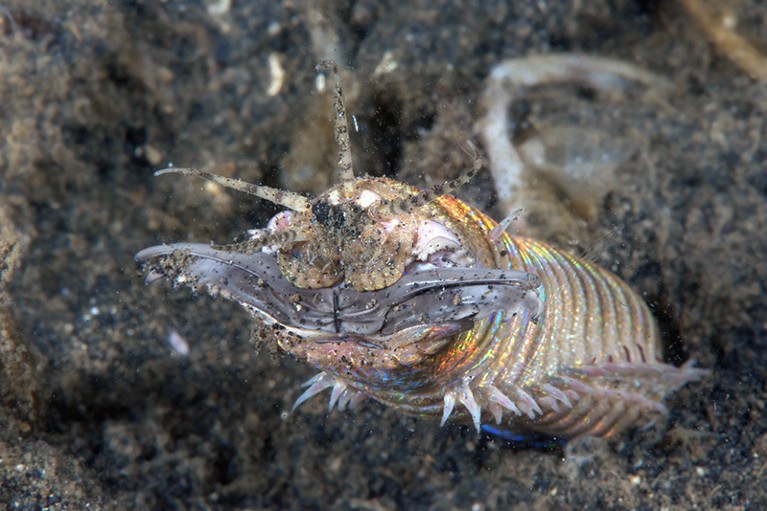[ad_1]
The film Dune: Part Two might feature human actors Timothée Chalamet and Zendaya, but the biggest stars — at least literally — are the sandworms. The sandworms are central to the desert ecosystem of the fictional planet Arrakis, the film’s main setting, and to the culture of its inhabitants, the Fremen. Sandworms live underground and excrete a substance that becomes the all-important drug called the spice, and the Fremen ride them like giant sandy freight trains. In the film’s first glamour shot of a sandworm, a house-sized mouth ringed with teeth erupts out of the sand to swallow a whole platoon of soldiers.
To find out whether the fictional worms in Dune have anything in common with real worms, Nature spoke to palaeontologist Luke Parry at the University of Oxford, UK. He studies worms from the Cambrian and Ordovician periods, which together lasted from roughly 540 million to 444 million years ago.
Dune’s sandworms can grow to at least 450 metres long, about 15 times the size of the longest blue whale. How big do real-life worms get?
There are annelid worms that get up to several metres in length called eunicid worms, a type of bristle worm. They’re pretty gnarly — they have big jaws, they look a bit like Graboids from the 1990 film Tremors. Some of them are ambush predators. They eat octopuses, squid, vertebrates.
There are some earthworms that get really big, as well. Megascolides reaches up to 2 metres. The biggest ones are from Australia.

The ambush predator called the bobbit worm (Eunice aphroditois) can reach 3 metres long.Credit: Constantinos Petrinos/Nature Picture Library
Do any of them have teeth?
The worms in Dune have lots of teeth around their mouths, and that’s what the Fremen use to make their crysknives. There are worms like that, called priapulids. These are the sorts that were making the first complex burrows in the early Cambrian. They use all of these teeth, called scalids, on a proboscis to drag themselves through burrows. Alitta worms — sandworms — and ragworms have teeth for catching prey. Some leeches have teeth.
The sandworms in Dune have totally changed their planet by excreting the valuable drug called the spice, making the weird blue liquid called the Water of Life and more. Have worms on Earth changed our planet?
Worms on Earth were responsible for burrowing into sediments over half a billion years ago and changing marine ecosystems forever. It’s part of what we call the Cambrian explosion, one of the most profound changes on the planet.
Before the advent of worms, the sea floor would have been smothered with what are called microbial mats. All the sediment would have been anoxic, without oxygen. If you’ve ever gone swimming in a river or a lake and it’s muddy and you plunge your foot into it, and it’s smelly and anoxic, that’s basically what the entire sea-floor environment would have been around the world.
Then, all of a sudden, some animals evolve a wormy body plan that allows them to move in three dimensions. They start burrowing into sediments, and that means that oxygen can get into the sediments and complex animal life can live there. It opens up new ways of making a living. Worms are part of this fundamental restructuring of the world.
When the Fremen in Dune want to ride a sandworm, they summon one with a device called a thumper that drums the ground. Do real worms sense vibrations?
Yeah, a common thing that birds do for catching earthworms is drumming on the ground, to bring them to the surface of the soil. Seagulls do it. Unfortunately, I don’t think the seagulls ride around on them.
If you were the right size to ride on a worm, do you think it would be similar to riding a sandworm in Dune?
It depends what sort of worm it was and where it was going. There are lots that crawl around on the surface of sediments — maybe you could ride those around. For worms that burrow, I think you’d find it quite uncomfortable and confining.
Any other favourite worm facts?
There are about 30 animal body plans — what we call the animal phyla, the big groups that we chop up animal diversity into — and more than half of them are worms. It’s a really good, versatile way of making a living. Lots of things that didn’t start off as worms just become worms. There are groups of lizards that lose their limbs, like snakes and amphisbaenians, worm lizards. There are worms that live in hydrothermal vents in the deep sea.
How do you feel about having the organisms you study portrayed on screen?
I think it’s awesome. Although there’s nothing like the worm in Dune that’s alive today, some of the things that it does, or some of the ways it looks, are actually like some of these really unfamiliar organisms that we find in the ocean. If a handful of people find out about those animals as a result of watching Dune, I think that’s awesome, because these things are — life is — amazing and diverse.
This interview has been edited for length and clarity.
[ad_2]
Source Article Link

